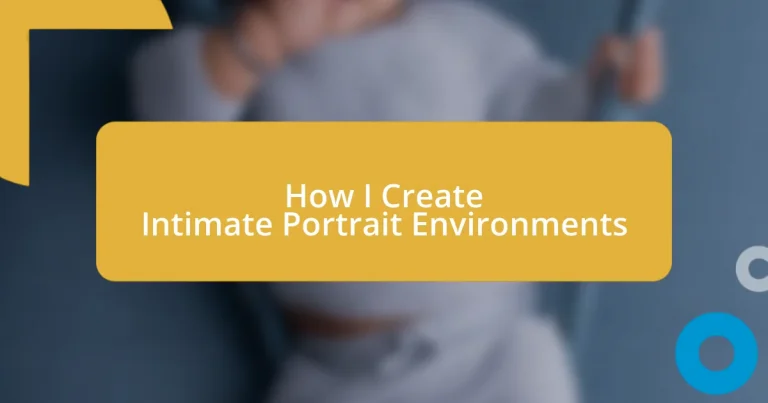Key takeaways:
- Intimate portraiture relies on creating a comfortable environment and building genuine connections with subjects, often through open-ended conversations and personal props.
- Selecting the right location emphasizes the subject’s personality; factors like comfort, lighting, and ambiance significantly influence the intimacy of the portrait.
- Final touches, such as adjusting details and providing feedback, can enhance the authenticity of a portrait, helping subjects feel more confident and relaxed.
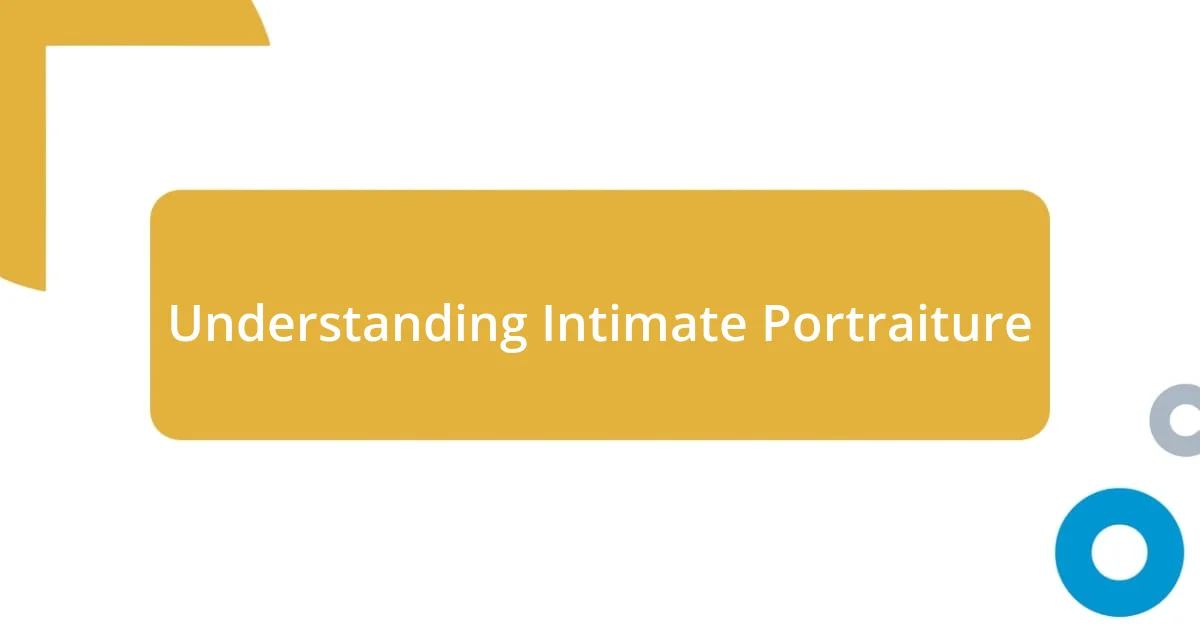
Understanding Intimate Portraiture
Intimate portraiture is all about capturing the essence of a person in a way that resonates deeply with the viewer. I recall a session where I worked with an artist who was initially reserved. As we chatted about her creative process, I observed how her expressions transformed; it reminded me that real intimacy often lies in uncovering the stories behind the surface. Isn’t it fascinating how a simple smile or a thoughtful gaze can reflect a lifetime of emotions?
In my experience, the environment plays a crucial role in conveying intimacy. One time, I transformed a cozy corner of my studio into a vibrant nook filled with warm lights and personal items significant to my subject. It created an instant comfort level. It’s incredible how spaces can evoke feelings and reveal things about a person that aren’t immediately visible.
Another layer to intimate portraiture is the connection built during the shoot. I often find myself asking open-ended questions, encouraging my subjects to share their thoughts. This approach not only helps them feel seen but also adds depth to the portrait. Have you noticed how authenticity shines through when people are relaxed and open? It’s those moments of vulnerability that make the images truly memorable.
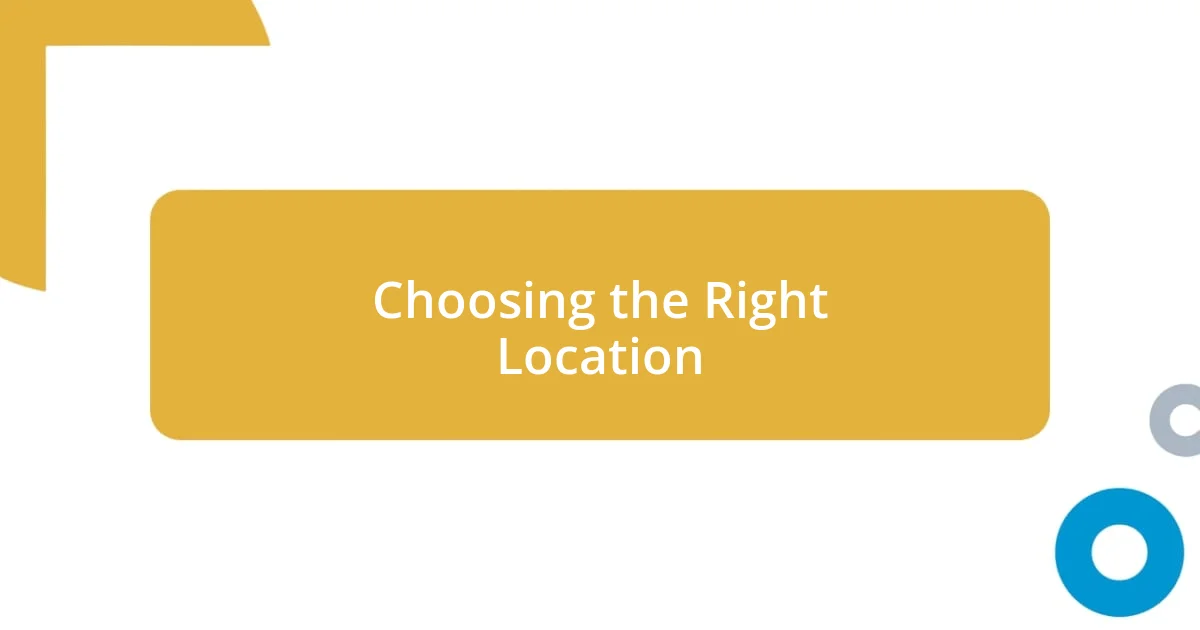
Choosing the Right Location
Choosing the right location is essential for creating an intimate atmosphere in portraiture. I remember one session in a quaint little cafe, filled with soft lighting and the soothing sound of coffee machines. This setting didn’t just frame my subject; it enveloped her in a familiar warmth, allowing her to relax and open up. When selecting a location, I always consider how the backdrop can reflect the personality and story of the person I’m photographing.
Here are some key factors to think about when choosing a location:
- Comfort: Is the space inviting? Familiar surroundings can ease tension.
- Lighting: Natural light can create a soft, flattering effect. I tend to scout locations during golden hour for that warm glow.
- Meaning: Personal significance can enrich the experience. For instance, I once shot a dancer in her old studio, where every corner resonated with her journey.
- Ambiance: The overall vibe should align with your subject’s essence. Whether it’s a rustic cabin or a vibrant street, it’s worth considering how it reflects their story.
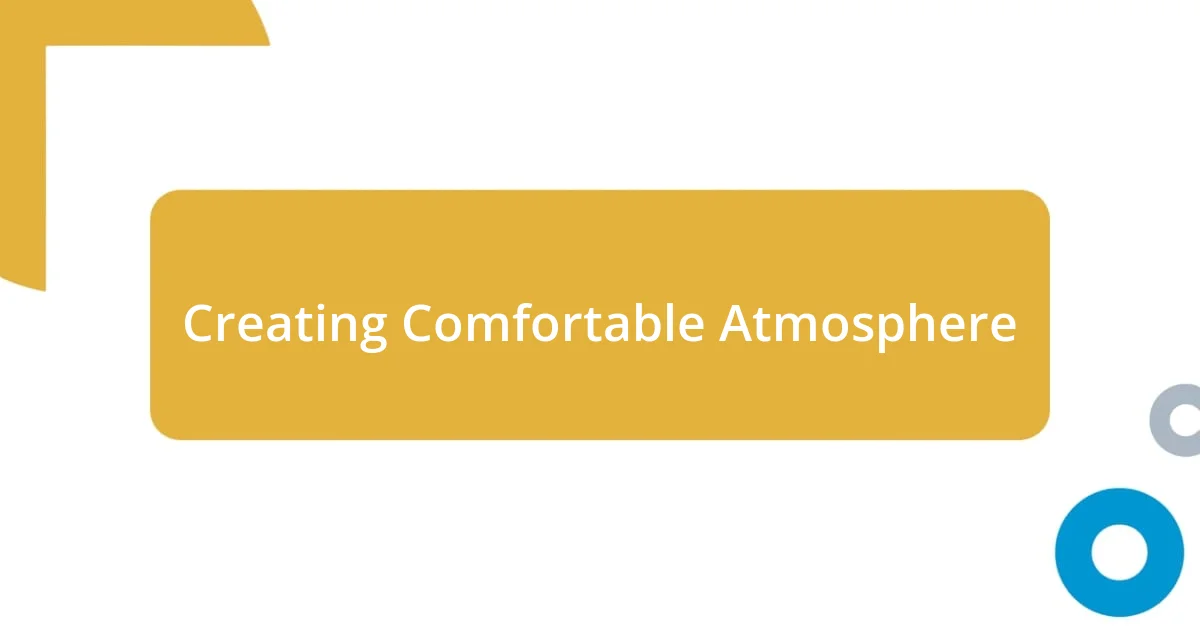
Creating Comfortable Atmosphere
Creating a comfortable atmosphere is pivotal in intimate portraiture. I remember once setting up a session at a friend’s home, where she decorated the living room with her own art, instantly creating a setting that felt personal and inviting. As I walked in, I could see her shoulders drop; it was like she transformed from a subject into a storyteller, sharing her passions. This simple act of surrounding her with meaningful items made a world of difference in how comfortable she felt.
Creating a welcoming space is about tailoring it to the subject’s personality. I often bring along soft blankets or favorite cushions to make the environment cozier. I vividly recall a shoot where I added a plush chair, and the moment my subject sank into it, she let out a sigh of relief that signaled she felt at home. The little things like these can evoke a sense of safety, which promotes openness and vulnerability, key elements for capturing genuine expressions.
Music can also enhance the comfort level significantly. I often curate playlists that resonate with my subjects. One time, I played some soft jazz during a session, and suddenly, the atmosphere shifted. My subject began swaying gently, her smile becoming more authentic as she released the tension of being in front of the camera. It’s amazing how sounds can envelop you in warmth, inviting deeper connections and allowing the essence of the person to shine through in the portraits.
| Element | Impact on Atmosphere |
|---|---|
| Personal Items | Creates familiarity and a sense of belonging; invites storytelling. |
| Comfortable Seating | Encourages relaxation; reduces tension and promotes natural expressions. |
| Soft Music | Enhances mood; facilitates a flow of emotions and connection. |
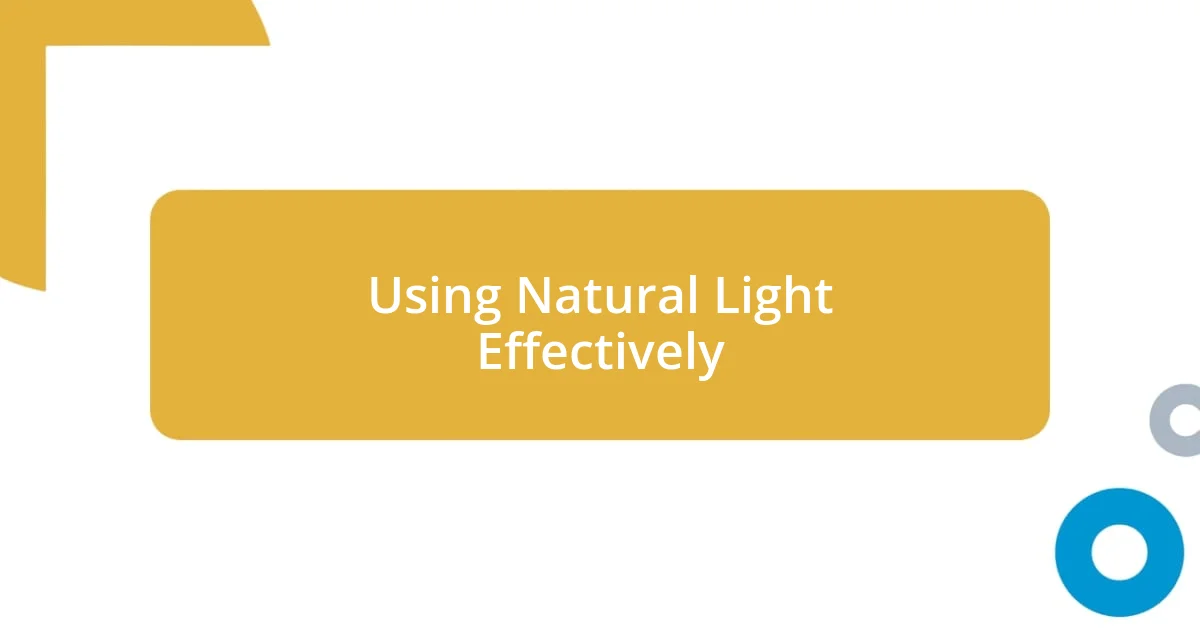
Using Natural Light Effectively
Natural light is one of my best friends when it comes to portrait photography. I often find myself scouting for those cozy corners where sunlight filters in softly, creating an ethereal glow. I recall a morning spent in a sun-drenched bedroom, where the light danced gently off the walls, illuminating my subject’s face in a way that felt almost magical. It’s moments like these that remind me how light can transform an ordinary scene into something extraordinary.
Manipulating natural light also involves understanding its quality and direction. Have you ever played with shadows? I’ve noticed how softer shadows can enhance the depth and dimension of a portrait, adding a layer of intimacy. On one occasion, I positioned my model near a window where the light streamed in at an angle, creating a lovely cascade of shadows that highlighted her features beautifully. Those subtle elements of light and darkness invite the eye to explore the image as a whole.
Finally, timing is crucial when working with natural light. The golden hour—about an hour after sunrise or before sunset—offers a warm, diffused light that is simply hard to beat. I once set up my camera just as the sun dipped below the horizon, bathing my subject in a warm glow. The kind of warmth that speaks to the heart. Capturing that essence became more than just a photo; it turned into a shared moment of serene beauty, forever etched in my memory and in hers. Isn’t it fascinating how light can not only illuminate but also connect us?

Incorporating Personal Props
Incorporating personal props can truly elevate the intimacy of a portrait session. I once worked with a musician who brought her guitar along to a shoot. As she held it, her eyes sparkled with nostalgia, and it opened a door to her story. I could sense how the props became extensions of her emotions, allowing her to express herself in ways words couldn’t capture. Doesn’t it make you wonder how much a single object can reveal about a person?
Another memorable moment occurred when a subject brought along a handwritten letter from a loved one. As she read the sweet words, a wave of emotion washed over her face. In that instant, she transitioned from being just a model to a storyteller, and I found myself capturing a profound connection. This illustrates how personal items can create a bridge between the subject’s inner world and the visual narrative we’re trying to craft.
Utilizing personal props is not just about adding decor; it’s about weaving in the essence of the individual. During a session with a painter, I encouraged her to showcase her brushes and even a canvas with her current work. As she engaged with these tools, it felt like I was witnessing her creative spirit come alive. It’s incredible how props can prompt genuine interactions and reveal the beautiful layers of one’s identity, isn’t it?

Communicating with Your Subject
Communicating with my subject is a delicate dance that sets the tone for the entire portrait session. One time, I remember working with a shy individual who initially felt uneasy in front of the camera. I took a moment to share a little about myself and my own discomforts with being photographed, which seemed to lift a weight from her shoulders. It was like a light bulb went off—we both were just humans, trying to connect in a space that felt vulnerable yet intimate. Isn’t it amazing how sharing our own stories can create an instant rapport?
I also find that asking open-ended questions can lead to unexpected revelations during a shoot. I once asked a subject what her dream vacation would be like, and as she animatedly described it, her expressions transformed. Her smile grew wider, and genuine joy filled her eyes, easily capturing a spirit that I hadn’t seen before. Engaging with my subjects this way not only deepens our connection but also translates into more authentic moments. How often do you wish to see the real person behind the facade?
Another essential aspect is paying attention to non-verbal cues. I recall shooting an elderly gentleman who, despite his initial stoicism, was reveal a world of stories through the slightest shifts in his posture. I made an effort to maintain eye contact and nod along as he spoke, encouraging him to share his experiences. Those small moments of acknowledgment turned into the most poignant expressions on his face, revealing years of wisdom and emotion. When you emphasize listening, how does that change the energy in the room?
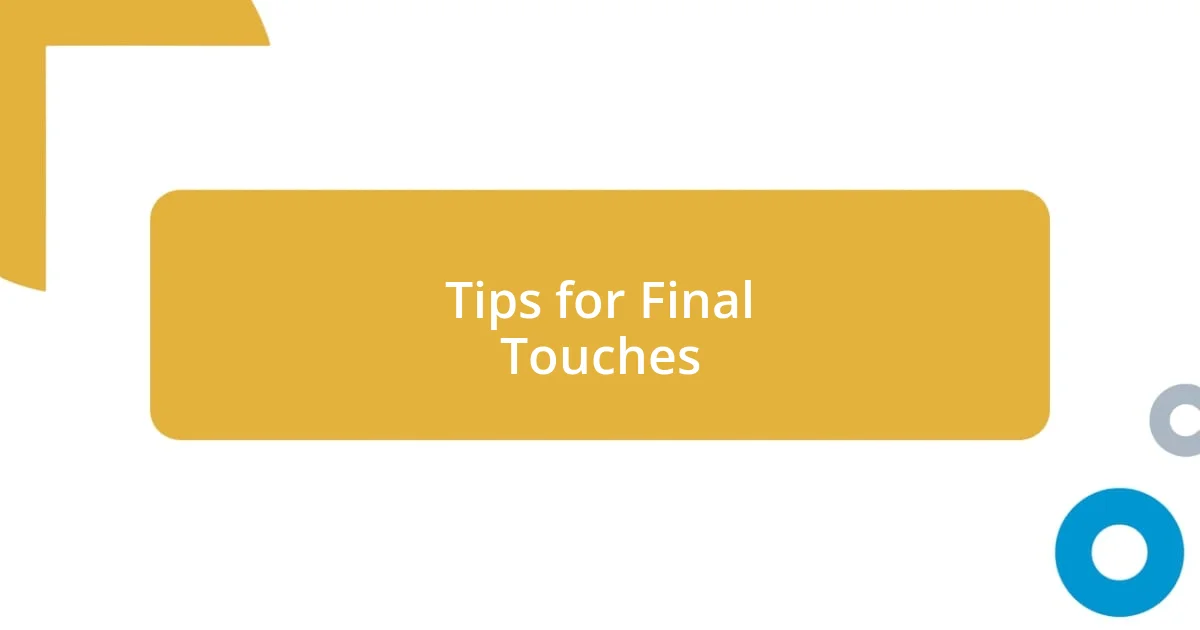
Tips for Final Touches
Adjusting the final touches can truly enhance the depth of intimacy in portraits. One time, after a shoot, I noticed a small detail that might have been overlooked: a stray hair out of place on my subject’s face. I gently brushed it aside; suddenly, her confidence seemed to blossom, allowing a radiant authenticity to shine through. It’s often the tiniest adjustments that can make the biggest difference, don’t you think?
Paying attention to the environment can also elevate the entire composition. I remember finishing a session in a cozy café and realizing the lighting was shifting beautifully as the sun began to set. I encouraged my subject to shift closer to the window, where the golden hour light created this soft glow around her. Those moments of spontaneity, inspired by the surroundings, can lead to breathtaking outcomes. Have you ever experienced how light can transform a scene entirely?
Finally, don’t underestimate the power of feedback. During one session, I found myself scanning the images on my camera and noticed my subject’s uncertainty. I showed her a few photos, sharing my excitement about what I captured, which sparked her own enthusiasm. Her expressions became more relaxed and genuine as she started to see herself through my lens. It’s incredible how a little affirmation can unlock the full potential of a moment, isn’t it?












